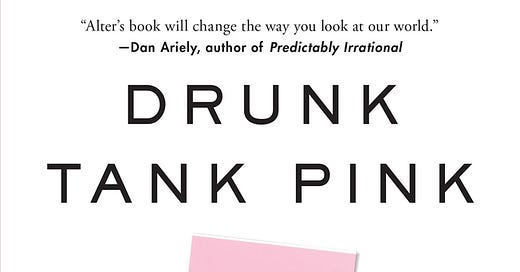Hidden in plain sight
Adam Alter’s book Drunk Tank Pink shares some truly eye-opening insights for how our surroundings influences our behavior.
Drunk Tank Pink: And Other Unexpected Forces That Shape How We Think, Feel, and Behave
by Adam Alter
What if I told you that the color of your surroundings or the layout of a supermarket could influence your decisions without you realizing it? In the book Drunk Tank Pink, author Adam Alter does just that, as he dives deep into the hidden forces that shape our behavior; the insights are fascinating.
I heard about Drunk Tank Pink while listening to a podcast last fall. Being obsessed with the idea that most of what we think we know is wrong, I was intrigued enough to get a copy; I was not disappointed. The book highlights how oft-hidden forces influence our thoughts, feelings, and actions.
What I enjoyed most: I’m a sucker for research, anecdotes, and strong storytelling, all of which this book has in spades. Citing copious data mined from eye-opening studies, Alter shares how seemingly negligible environmental factors can significantly impact our behavior.
Drunk Tank Pink examples I found interesting:
Color can calm: After researchers painted police holding cells a specific shade of pink, now known as Drunk Tank Pink, they noticed that potentially volatile detainees behaved more calmly and had fewer violent outbursts.
Teachers have a huge role to play: Teachers’ expectations of a student's performance can influence learners’ scores. The author highlights how social cues and authority figures can unconsciously shape our behavior.
Weather impacts more than we realize: Sunny days can boost our moods and lead to more optimistic behavior; cloudy days have been shown to make subjects more risk-averse. This, he writes, underscores the influence of seemingly external factors on decision-making.
My favorite topic: social media
Given that I hate social media, it should be no surprise that the section on how social hijacks our brains was my favorite part of the book. He describes how much of our behavior is heavily influenced by the platforms’ ability to capture and maintain our attention, which promotes distractability and decreases our attention spans.
For young users, particularly, the results can be even more nefarious, as electronic devices have been shown to impair children's development and alter their behavior. Social media, when paired with excessive screen time, Alter writes, has been shown to impact youth’s emotional well-being as well, as they attempt to navigate a world full of hyper-stylized, AI-generated images of beauty.
Who should read the book?
Anyone looking for a great read this summer should pick up Drunk Tank Pink. It will go a long way in helping readers recognize and manage the internal cues that shape their decisions.




